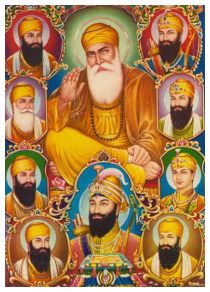Post by Leon on Apr 25, 2012 20:49:05 GMT

The founder of the Sikh religion, Guru Nanak was born on April 15, 1469 in the Western Punjab village of Talwandi. He was born to a simple Hindu family. His father Mehta Kalian Das was an accountant in the employment of the local Muslim authorities.
The Second Master: Guru Angad (1504 to 1552)
The son of a prosperous Hindu trader, Bhai Pheru, Guru Angad was an ardent devotee of the Hindu goddess Durga. Lehna, as he was known before becoming Guru was born on March 31, 1504 in the village of Matte-di-Sari but eventually his family moved to Khadur.
The Third Master: Guru Amar Das (1479 to 1574)
Guru Amar Das was born in the village of Basarke on May 5, 1479. He was the eldest son of Tej Bhan a farmer and trader. Guru Amar Das grew up and married Mansa Devi and had two sons Mohri and Mohan and two daughters Dani and Bhani. He was a very religious Vaishanavite Hindu who spent most of his life performing all of the ritual pilgrimages and fasts of a devout Hindu.
The Fourth Master: Guru Ram Das (1534 to 1581)
Guru Ram Das was born on September 24, 1534 to simple God-fearing parents, Hari Das and Anup Devi of Lahore. Known as Jetha meaning the first born, he was a handsome young man. When he grew up he could always be found in the company of religious men.
The Fifth Master: Guru Arjan (1563 to 1606)
Guru Arjan was the youngest son of Guru Ram Das and Mata Bhani. He was born at Goindwal on April 15, 1563. In 1579 Guru Arjan was eventually married to Ganga Devi daughter of Krishan Chand in 1579.
The Sixth Master: Guru Hargobind (1595 to 1644)
Guru Hargobind was born at Wadali village in June 1595 and was the only child of Guru Arjan Dev. He was invested with the Guruship on May 25, 1606 just days before his fathers martyrdom. From a young age he was educated in the sciences, sports and religion as his father had insisted. Baba Buddha was responsible for overseeing the Guru's religious teachings.
The Seventh Master: Guru Har Rai (1630 to 1661)
Guru Har Rai was born on January 16, 1630 in Kiratpur to Baba Gurditta the eldest son of Guru Hargobind. From a very young age he exhibited a sensitivity to all living things and endeared himself to his grandfather Guru Hargobind.
The Eighth Master: Guru Harkrishan (1656 to 1664)
Guru Harkrishan was born on July 7, 1656 to Guru Har Rai and Krishan Kaur. Before his death in October 1661 Guru Har Rai had appointed his younger son Harkrishan as the next Guru as opposed to his elder son Ram Rai who was in collusion with the mughals. Guru Harkrishan was only five years old when he received the guruship.
The Ninth Master: Guru Tegh Bahadur (1621 to 1675)
Guru Tegh Bahadur was the youngest son of Guru Hargobind and Bibi Nanki and was born at Amritsar on April 1, 1621. From a young age Tegh Bahadur was trained in the martial arts of swordsmanship and horse riding as well as religious training by the wise Baba Buddha and Bhai Gurdas.
The Tenth Master: Guru Gobind Singh (1666 to 1708)
Guru Gobind Singh was also a warrior, poet and philosopher. He succeeded his father Guru Tegh Bahadur as the leader of Sikhs at a young age of nine. He contributed much to Sikhism; notable was his contribution to the continual formalisation of the faith which the first Sikh Guru Nanak Dev had founded.





